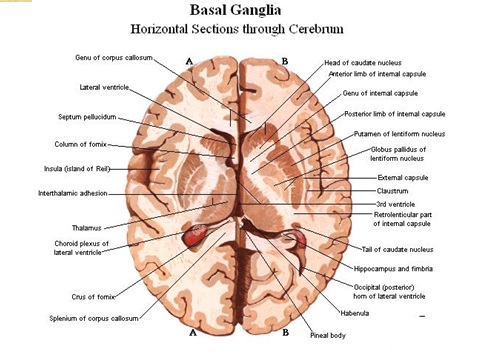Basal Nuclei
Introduction
They are groups of cell bodies called nuclei (previously called ganglia).
They lie deep within the cerebral hemispheres
They are relay stations where impulses are passed from one neurone to the next in a chain.
Location And Subdivisions Of Basal Ganglia
Location :
Subcortical, lies deep within the cerebral hemispheres
Consist of the caudate nucleus, putamen, globus pallidus and substantia nigra
The putamen and caudate nucleus along with the interposed anterior limb of the internal capsule are collectively known as the corpus striatum (i.e. striated body) because of their appearance.
Similarly, the shape of the putamen and globus pallidus resembles a lens, and they are collectively called the lenticular nucleus.
(Putamen + caudate nucleus + internal capsule = corpus striatum
Putamen + globus pallidus = lenticular nucleus)
Functions
Basal ganglia : associated with motor and learning functions
It influences the skeletal muscle tone.
Establishes postures.
Monitors and coordinates slow, sustained contractions related to posture and support.
Controls voluntary movements
Selects and maintains purposeful motor activity
Suppresses unwanted or useless movement.
Balances the excitatory and inhibitory inputs to the neurones innervating skeletal muscles
When the basal nuclei are affected by disease - say in disorders like Huntington disease, Parkinson's disease or Wilson's disease - the person has unwanted movements, such as involuntary jerking movements of an arm or leg or spasmodic movement of facial muscles.
Injury to this area leads to rigidity, hypotonia
In addition the basal ganglion houses the amygdala, which mediates inborn and acquired emotional responses.
Mediates both conscious and unconscious emotional feelings through connections with the prefrontal lobe.
Disorders linked with the basal ganglia
Huntington's disease
Parkinson's disease
Cerebral palsy: basal ganglia damage during second and third trimester of pregnancy
Wilson Disease
(Hepatolenticular Degeneration); Inheritance of a mutation on chromosome 13. The mutation prevents the body from eliminating excess copper. Neurological damage primarily occurs in the putamen and globus pallidus.
* * * * * * * * *




